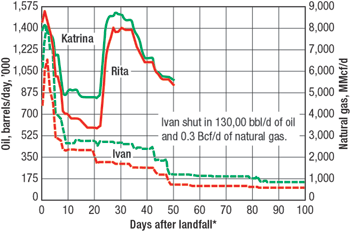What's new in production
Recovery. The US Gulf of Mexico’s pace of recovery is much slower than expected after the passage of three major hurricanes in two years. Recovery from Hurricane Ivan was nearly complete in less than two months. This season’s double hit with hurricanes Katrina and Rita is taking more than twice as long as the Ivan recovery and is reflective of the extensive damage caused by this season’s activity (see graph). The initial shut-in period during Rita’s passage closed all of the Gulf’s production for close to two weeks. As of mid-October, operators have restored 37.7% of the oil production (62.3% still shut in) and 40.1% of the gas production (59.9% still shut in). A small portion of the production, around 2%, is lost for an extended time due to the destruction of many older producing platforms. Production from these wells may be permanently lost as uneconomic, since operators will need to build new production facilities and redrill some wells. The State of Louisiana’s Office of Conservation reports that its onshore and offshore natural gas production has returned to 765 MMcfpd, 34.2% of pre-storm levels. Almost half of the state’s wells, 2,811 oil and gas wells, remain shut in. Operators have not reported on over 25% of the producing wells. Rig use has diminished in the Gulf as well. According to ODS-Petrodata’s Offshore rig Locator, contracted rig utilization has slipped to 79.1%, down from its 81.4% September value. Many onshore logistical facilities are damaged or destroyed and will take time to rebuild, which is hampering offshore operations. Regrouping skilled personnel is also a continuing issue. In a related rig matter, Noble announced that it is developing a new operating standard for its semisubmersible fleet, dubbed API RP-2SK. This new approach will meet Deep Star’s 100-yr storm conditions. Begun last year, Noble will complete the standard by 2007. The temporary loss of GOM production has revealed how tightly the US supply chain is stretched and the need for more investment to meet continually expanding demand. The US GOM and affected onshore region will take much longer to recover this time than it has in past years. Composites. Recently, the Fourth International Conference on Composite Materials and Structures for Offshore Operations (CMOO-4) brought research and engineering experts together in Houston to share their experience and advances over the past year. CMOO is organized each year by the University of Houston’s Composite Engineering and Applications Center for Petroleum Exploration and Production.
Composite seabed structures are being researched because 86% of new projects are in 2,000-m water depths or deeper. Composite piping has advantages over conventional steel tubes including lighter weight, easy fabrication, corrosion resistance, reduced maintenance cost and reduced cost over its lifetime. A Statoil representative reported on the failure of a 6.5 km composite pipeline installed for Asgard field in the North Sea. The pipeline was laid in 300 m water depth and was designed for continuous operation at 380 bar, delivering methanol/ glycol for injection. The pipe failed when the local bending strains plus the stress of high pressure led to axial expansion. The line was abandoned in place. The presenter suggested that future composite pipelines be thickened slightly to match the axial expansion strength of steel pipe. He encouraged pipe-laying trials before committing to laying future lines. He also suggested that lower startup pressures be used to gain experience with the pipe before flowing at full pressure. A CooperCameron incubator project performed an extensive study of thick composite pressure vessels to address long-term fatigue problems with steel catenary risers. Using dual-element composites, researchers at DeepSea Engineering, Cooper Cameron and BTG, USA, built cylindrical pipe to 1.5-in. thickness using a sandwich of materials. The sandwich increases stiffness to resist buckling and lowers the carbon fiber mass needed, which reduces material costs. The thick-walled pipes are topped with similarly constructed domes to form a dual-element buoyancy unit (DEBU) – a pressure vessel for deepsea buoyancy. End-joins are formed of rings made from titanium, steel and carbon fiber. At depth, compressive forces enhance joint sealing. DEBU, 1-m in diameter by 4.5-m in length, were tested with good results. The next step is to take the composite structures to 4,000-m water depth for validation. The research opens applications for many different deepsea pressure vessels, since the components are scalable. Composite pipe has the advantage of including power conductors and optical fibers in the construction process to produce a pipe that can deliver electric power and data to tools. A consortium of Airborne, BJ Services, Shell Global Solutions, Smartec, ETH Zürich and KU Leuven built a production process and plant to produce composite pipe with these added capabilities for use in coiled tubing operations. Field trials of the new coiled tubing began this summer at a test well in the Netherlands.
|
|||||||||||
- What's new in production (February 2024)
- Prices and governmental policies combine to stymie Canadian upstream growth (February 2024)
- U.S. operators reduce activity as crude prices plunge (February 2024)
- U.S. producing gas wells increase despite low prices (February 2024)
- U.S. drilling: More of the same expected (February 2024)
- U.S. oil and natural gas production hits record highs (February 2024)





